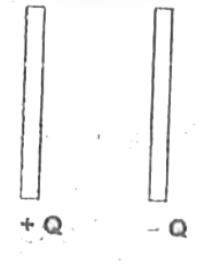A parallel plate capacitor is charged and then isolated. On increasing the plate separation
Charge Potential Difference Capacitanceremains constant remains constant decreases
Charge Potential Difference Capacitanceremains constant increases decreases
Charge Potential Difference Capacitanceremains constant decreases increases
Charge Potential Difference Capacitanceincreases decreases increases
The correct Answer is:B
To solve the problem regarding the behavior of a parallel plate capacitor when the plate separation is increased after it has been charged and isolated, we will follow these steps:
1. Understand the Initial Conditions:
- A parallel plate capacitor is charged and then isolated. This means that the charge (Q) on the capacitor plates remains constant after isolation.
2. Capacitance Formula:
- The capacitance (C) of a parallel plate capacitor is given by the formula:
C=Aϵ0d
where A is the area of the plates, ϵ0 is the permittivity of free space, and d is the separation between the plates.
3. Effect of Increasing Plate Separation:
- When the plate separation d is increased, the capacitance C decreases because capacitance is inversely proportional to the distance between the plates.
4. Charge Remains Constant:
- Since the capacitor is isolated, the charge Q on the plates does not change. Therefore, we have:
Q=C⋅V
where V is the potential difference across the capacitor.
5. Relating Charge, Capacitance, and Voltage:
- Rearranging the equation Q=C⋅V, we can express the potential difference as:
V=QC
- Since Q remains constant and C decreases (due to increased plate separation), it follows that V must increase.
6. Conclusion:
- Therefore, when the plate separation is increased:
- The charge Q remains constant.
- The capacitance C decreases.
- The potential difference V increases.
Final Answer:
- Charge remains constant, capacitance decreases, and potential difference increases.
- A parallel plate capacitor is charged and then isolated. This means that the charge (Q) on the capacitor plates remains constant after isolation.
- The capacitance (C) of a parallel plate capacitor is given by the formula:
C=Aϵ0d
where A is the area of the plates, ϵ0 is the permittivity of free space, and d is the separation between the plates.
- When the plate separation d is increased, the capacitance C decreases because capacitance is inversely proportional to the distance between the plates.
- Since the capacitor is isolated, the charge Q on the plates does not change. Therefore, we have:
Q=C⋅V
where V is the potential difference across the capacitor.
- Rearranging the equation Q=C⋅V, we can express the potential difference as:
V=QC
- Since Q remains constant and C decreases (due to increased plate separation), it follows that V must increase.
- Therefore, when the plate separation is increased:
- The charge Q remains constant.
- The capacitance C decreases.
- The potential difference V increases.
- Charge remains constant, capacitance decreases, and potential difference increases.
Topper's Solved these Questions
- ELECTROSTATICSBOOK - DC PANDEY ENGLISHCHAPTER - ELECTROSTATICSEXERCISE - JEE Advanced
44 Videos
- ELECTROSTATICSBOOK - DC PANDEY ENGLISHCHAPTER - ELECTROSTATICSEXERCISE - Comprehension
36 Videos
- ELASTICITYBOOK - DC PANDEY ENGLISHCHAPTER - ELASTICITYEXERCISE - Medical entrances s gallery
21 Videos
- EXPERIMENTSBOOK - DC PANDEY ENGLISHCHAPTER - EXPERIMENTSEXERCISE - Subjective
15 Videos
Similar Questions
A parallel plate capacitor is charged and then isolated. The effect of increasing the plate separation on charge, potential and capacitance respectively are
View SolutionA parallel plate capacitor is charged from a cell and then isolated from it. The separation between the plates is now increased
View Solution
Knowledge Check
A parallel plate capacitor is charged and then isolated. The effect of increasing the plate separation on charge, potential and capacitance respectively are
Aconstant, decrease, decreaseBincrease, decreases, decreasesCconstant, decreases, increasesDconstant, increases, decreases.
A parallel plate capacitor is charged from a cell and then isolated from it. The separation between the plates is now increased
View SolutionA parallel plate capacitor is charged and then the battery is disconnected. When the plates of the capacitor are brought closer, then
View SolutionA parallel plate capacitor is charged. If the plates are pulled apart
View SolutionConsider a parallel plate capacitor is charged by a constant current I, with plate area A and separation between the plates d. Consider a plane surface of area A/4 parallel to the plates and drawn symmetrically between the plates. Find the displacement current through this area.
View SolutionA parallel plate capacitor is charged and the charging battery is then disconnected. If the plates of the capacitor are moved farther apart by means of insulating handles:
View SolutionA parallel plate capacitor is constructed with plates of area 0.0280m2 and separation 0.550mm. Find the magnitude of the charge on each plate of this capacitor when the potential between the plates is 20.1V

View SolutionConsider a parallel plate capacitor having charge Q. Then,

View Solution
